How To Cook Steak On The Stovetop
This post may contain affiliate links. Read my full disclosure policy.
Pan-searing is the best—and easiest—way to cook a steak. Master this technique to whip up a steak that rivals your favorite steakhouse.
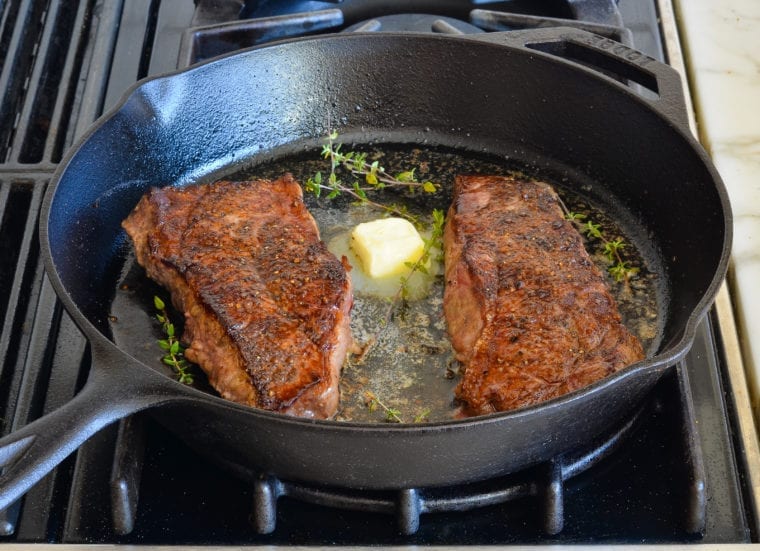
I love the kind of dinner you can whip up without relying on a recipe. Truth be told, good cooking is more about mastering techniques than following recipes, and the best dishes are often the simplest to make. A perfectly cooked steak is a prime example. With just a handful of ingredients and a single pan, you can prepare a steak that rivals anything you’d enjoy at a high-end steakhouse.
The secret is mastering the art of pan-searing. This classic technique involves cooking the surface of your food undisturbed in a piping hot pan until a crisp, golden-brown, and flavorful crust forms. It’s the key to building flavor and texture in a dish while preventing sticking and giving your meal a restaurant-quality appearance. Pan-searing is hands-down the best way to cook a steak (it works wonders for salmon and scallops, too), and it also happens to be incredibly easy.
What you’ll need to Cook Steak on The Stovetop
When it comes to beef, the best candidates for pan-searing are boneless, quick-cooking cuts between one and one-and-a-half inches thick, such as NY Strip, rib eye or filet mignon. (For larger or slow-cooking cuts, like beef tenderloin with red wine sauce or beef stew with carrots and potatoes, pan-searing is usually the first step, and then you finish the cooking in the oven.)
How to cook steak On The Stovetop
To begin, pat the steak dry with paper towels. (Any moisture on the exterior of the steak must first evaporate before the meat begins to brown.)
Season the steaks generously on both sides with salt and pepper; the seasoning will stick to the surface and help create a delicious crust.
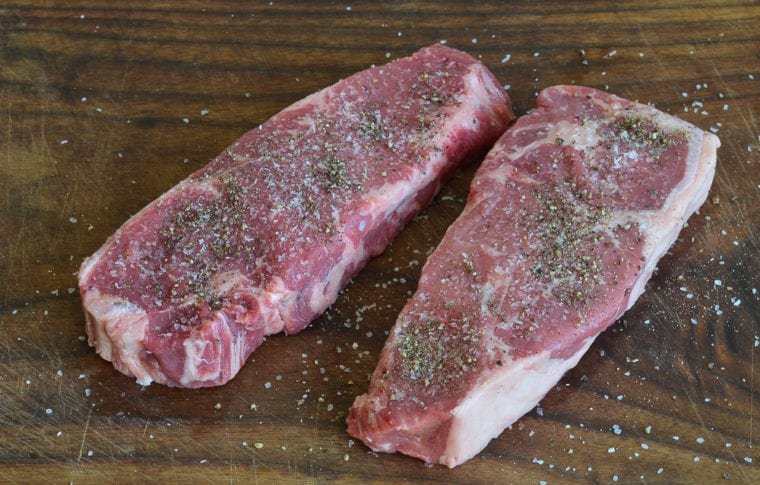
Turn on your exhaust fan and heat a heavy pan over medium-high heat until it’s VERY hot. The best pans for pan-searing are stainless steel or cast-iron since they can withstand high temperatures.
Add the oil to the pan. You’ll know it’s hot enough when it begins to shimmer and move fluidly around the pan.
Carefully set the steak in the pan, releasing it away from you so the oil doesn’t splatter in your direction. It should sizzle. (Use a pan that is large enough that it’s not such a tight fit or the pan will cool down and your food will steam instead of sear.)
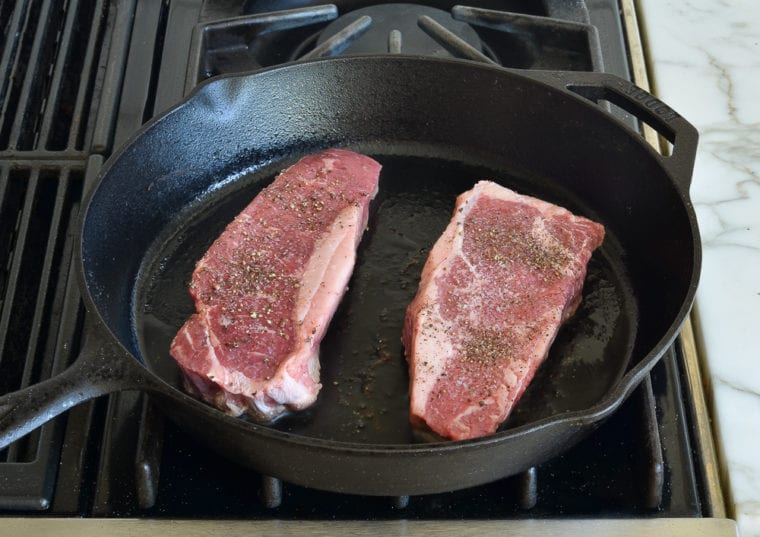
Leave it alone! Avoid the temptation to peek or fiddle or flip repeatedly. The steaks need a few minutes undisturbed to develop a brown crust. (Don’t worry about sticking; the steaks will release easily when they are ready to flip.)
Flip the steaks when they release easily and the bottom is a deep-brown color (usually about 3 minutes).
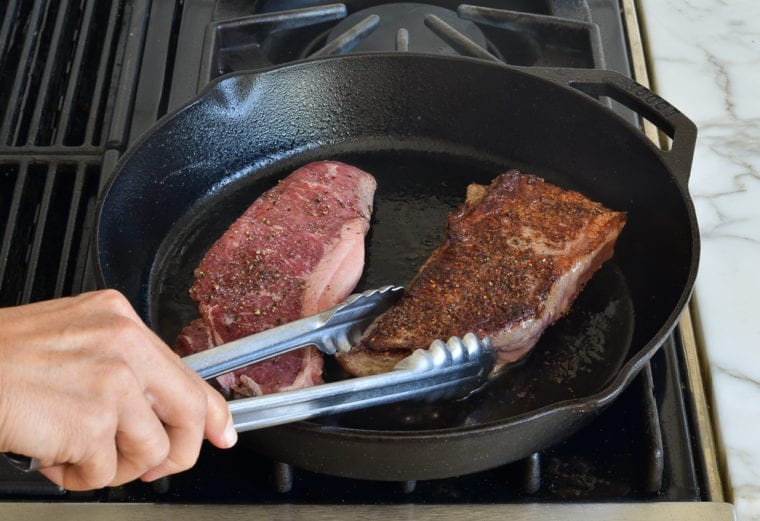
Continue to cook the steaks for another 3 to 4 minutes on the bottom side for rare or medium-rare.
During the last minute of cooking, add 1 tablespoon of butter and a few sprigs of fresh thyme to the pan with the steaks (this is optional but delicious).
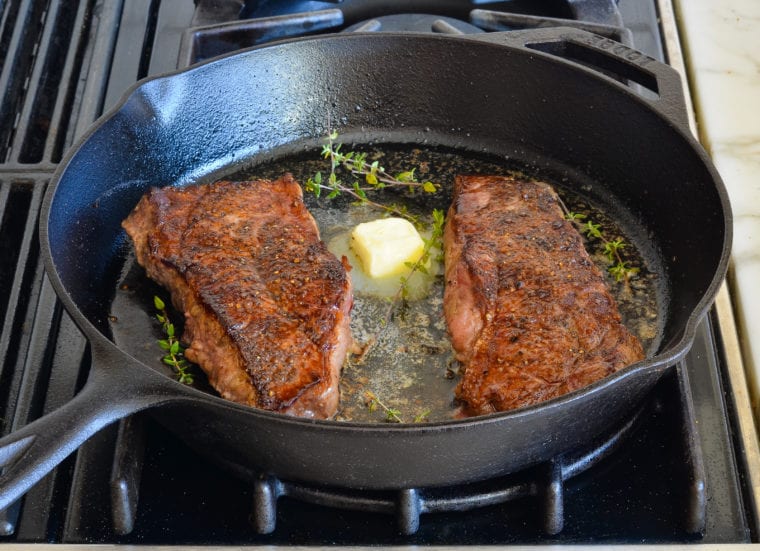
If you are serving the steaks unsliced, transfer them to plates and serve hot. If you plan to slice the steaks, transfer them to a cutting board and let rest, covered with aluminum foil, for 5 to 10 minutes; then slice thinly against the grain. (Resting allows the juices to redistribute from the outside of the steaks; if you slice them too soon, the juices will pour out of them.)
Video Tutorial
You May Also Like
- Beef Stew with Carrots & Potatoes
- Roast Beef Tenderloin with Red Wine Sauce
- Restaurant-Style Pan-Seared Salmon
- Red Wine Braised Short Ribs
- Steak Au Poivre
- Wedge Salad with Blue Cheese Dressing
Pan-Seared Steaks
Pan-searing is the best—and easiest—way to cook a steak. Master this technique to whip up a steak that rivals your favorite steakhouse.
Ingredients
- 2 (12-oz) New York strip or ribeye steaks or 4 (6-oz) filet mignons, about 1½ inches thick
- 1 heaping teaspoon kosher salt
- ½ teaspoon freshly ground black pepper
- 2 tablespoons vegetable oil
- 1 tablespoon unsalted butter
- A few sprigs fresh thyme leaves
Instructions
- To begin, pat the steaks dry with paper towels.
- Season the steaks all over with the salt and pepper.
- Turn on your exhaust fan and heat a heavy pan (preferably cast iron or stainless steel) over medium-high heat until it's VERY hot.
- Add the oil to the pan and heat until it begins to shimmer and move fluidly around the pan.
- Carefully set the steaks in the pan, releasing them away from you so the oil doesn’t splatter in your direction. The oil should sizzle.
- Leave the steaks alone! Avoid the temptation to peek or fiddle or flip repeatedly; the steaks need a few minutes undisturbed to develop a golden crust. Flip the steaks when they release easily and the bottom is a deep-brown color, about 3 minutes. Continue to cook the steaks for another 3 to 4 minutes on the second side for rare to medium-rare. (For medium, cook 4 to 5 minutes on second side; for well-done, cook 5 to 6 minutes on second side).
- During the last minute of cooking, add the butter and thyme sprigs to the pan with the steaks.
- If you are serving the steaks unsliced, transfer them to plates and serve hot. If you plan to slice the steaks, transfer them to a cutting board and let rest, covered with aluminum foil, for 5 to 10 minutes; then slice thinly against the grain.
Pair with
Nutrition Information
Powered by ![]()
- Per serving (4 servings)
- Serving size: 6-oz portion NY Strip
- Calories: 492
- Fat: 39 g
- Saturated fat: 14 g
- Protein: 33 g
- Sodium: 421 mg
- Cholesterol: 147 mg
This website is written and produced for informational purposes only. I am not a certified nutritionist and the nutritional data on this site has not been evaluated or approved by a nutritionist or the Food and Drug Administration. Nutritional information is offered as a courtesy and should not be construed as a guarantee. The data is calculated through an online nutritional calculator, Edamam.com. Although I do my best to provide accurate nutritional information, these figures should be considered estimates only. Varying factors such as product types or brands purchased, natural fluctuations in fresh produce, and the way ingredients are processed change the effective nutritional information in any given recipe. Furthermore, different online calculators provide different results depending on their own nutrition fact sources and algorithms. To obtain the most accurate nutritional information in a given recipe, you should calculate the nutritional information with the actual ingredients used in your recipe, using your preferred nutrition calculator.

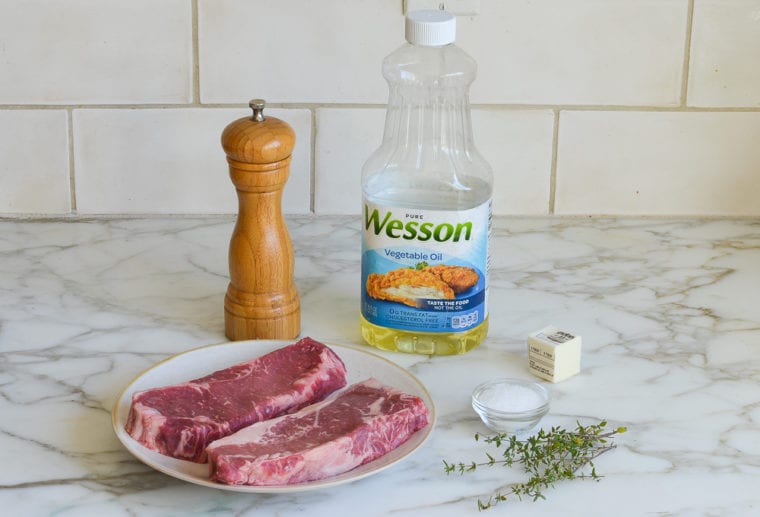
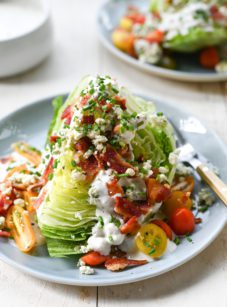
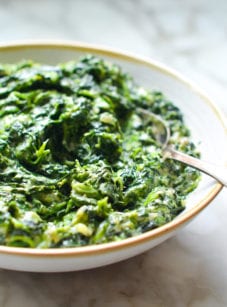
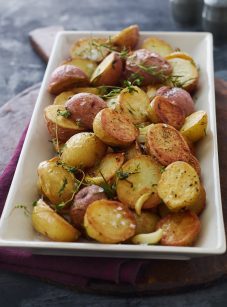
Hi Jenn. I am excited to try this recipe as where I live, I cannot have a grill. Do you have a suggestion as to whether you like the stainless steel or cast iron better? I see that you show cast iron.
Hi Nery, Either will work well, but if I had to choose, I’d probably go with the cast iron. I think you may get a slightly better sear with it.
This is good instruction for basic steak cooking. If you don’t have success with it…you need more practice.
Wow! I am stuck at home in Brussels and needed to start clearing out my freezer to find dinner. I found a lovely filet, but my grill was out of gas. Jenn to the rescue!!! My filet was absolutely gorgeous- perfectly cooked and seasoned! I already love your book and blog, but this was just superb. Thank you for keeping a girl well-fed.
Can you talk about oils? I see you use vegetable oil in this recipe rather than olive oil? Is there a reason?
Hi Mary, Vegetable oil has a lower smoke point than olive oil, so it’s better to use it when you’re heating oil to a high temperature. Hope that clarifies!
Thanks for saving me from the broiler…and the clean up. I followed your recipe and it came out delicious. And thanks for telling me not to play with it until it released. Because that is what I would have done. The steak came out medium rare, just the way we like it. It was a T-bone steak, BTW.
This reminded me of the heavens.
Telling people to GENEROUSLY season with SALT and pepper DESTROYED my rib eye. I cannot believe the good reviews. I did what you said and though MY gut saved the medium rare I wanted(had to cook at least twice as long as you suggested. However the steak was inedible! I’m serious. WAY too salty. I’m a vert experienced and good cook, but circumstances put me in a place I had to cook a rib eye on the stove. Very surprised that you publish such a disastrous recipe.
Other reviewers could not have used salt as you so illy advised.
But we did use salt as she “so illy advised”. You’re one of those toxic people who hates on other people. She has a lot of good reviews for a reason. Have a seat & try find something more productive to do
Wasn’t impressed at all….had to put it back on the stove for another 6 minutes and it was still inedible.
Amen brother
Apparently, you shouldn’t, since you are a very negative person and it manifests in your cooking outcome. Ever think, that it could be you?
Absolutely delicious! Never made one on the stove top before. Just the broiler and what a mess! This recipe is to die for, and if you have a splatter cover there is virtually no mess. Great flavor and super tender. I used ribeyes.
Delicious! I never make steak period. It was always awful…on the stove. Too much trouble to fire up the grill for me. I used the iron skillet and followed these instructions…I had a wonderful steak!!! I enjoyed every bite!!
Never cooked steak in a pan before. I’ve been missing something! So flavorful and inside perfect doneness! A good alternative to the grill!